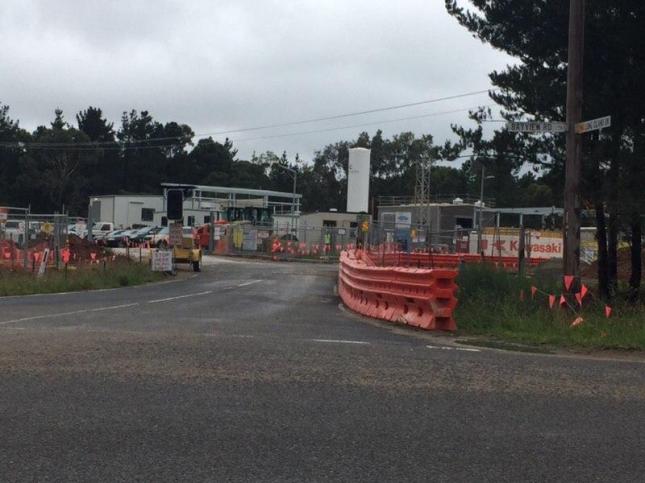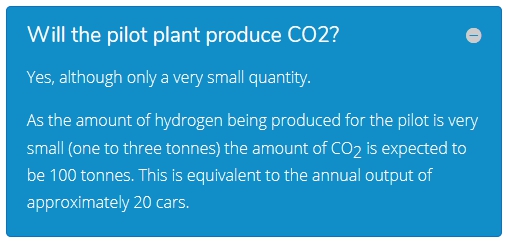
On my recent visit to Melbourne by bus and train I made a trip down to Hastings on the Mornington Peninsula to see if I could find the building site for the hydrogen liquefaction facility designed to support Victoria’s Hydrogen Energy Supply Chain (HESC) pilot project. A friend who lives locally came along with me on the Frankston train, we had planned to get a connecting bus onto Hastings, but my friend convinced me that we should get a car-share in Mordialloc and make the rest of the journey that way.
Reports in the media described the Kawasaki Heavy Industries facility as being built at the “Port of Hastings”. Our objective was to find the specific location, a street address, a map reference or both. We were confident we were on the right track shortly after exiting the Western Port Highway when we found pipeline markers running parallel to Frankston-Flinders Rd on our left as we headed south. We were even more confident when we saw the first of the Esso petroleum storage tanks to our left. We took a left turn where a rail spur crossed the road and another left onto Bayview Road. Where Bayview Road meets Long Island Drive we found the Kawasaki pilot site.

The pilot site location is more accurately described as being on Long Island Point, Hastings. The area was clearly established as an industrial export site long ago. Two Esso storage/export facilities are situated near two Bluescope Steel facilities. Both are serviced by rail spurs and, it should be assumed, pipeline infrastructure. We found some key information on public displays at the Hastings pier where the fishers moor their boats.

While we were in Hastings we picked up a copy of the Western Port News which was running a story by Keith Platt on the new Kawasaki facility and the resistance coming on the back of the ‘climate emergency’ declared by the Mornington Peninsula Shire Council in August 2019. The Western Port Shire Council (WPSC) have commissioned a report on the Kawasaki Heavy Industries and Hydrogen Engineering Australia project and a proposed container port. The report will likely be released sometime in April this year.

The HESC project has a 500 million price tag and includes the development of potential geological storage of CO2 sequestered from the Loy Yang brown coal to hydrogen facility in the Latrobe Valley near Traralgon. The WPSC may find itself up against the might of the Victorian and Australian governments in contesting the Kawasaki facility going beyond the pilot phase.

The CarbonNet CO2 storage project has been provided 150 million by the Victorian and federal governments so far. The HESC proponents downplay the sequestration component that would transform the hydrogen exported by Kawasaki Heavy Industries projects into “clean” or “blue” hydrogen. It is likely that the Loy Yang pilot will not immediately sequester the CO2 produced in the process of producing hydrogen from brown coal which is precisely what happened at the Gorgon Gas Project on Barrow Island off the Pilbara coast.

http://petergardner.info/2017/01/ccs-rumblings-in-gippsland/
Ninety Mile Against Carbon Storage (NMACS) is a grass roots group based in Gippsland that has been campaigning against the CarbonNet project. In their project briefing they start by providing some important context about the 2 billion in federal funding for carbon capture and storage going back to 2009.
When the Carbon Capture and Storage Flagships Program was established in 2009 by then Prime Minister Kevin Rudd it was a means of securing a low-emissions future for coal by supporting the construction and demonstration of large-scale integrated CCS projects in Australia.
https://www.ninetymileagainstcarbonstorage.org.au/carbonnet-project/
NMACS point out that the CarbonNet project is one of the survivors of the CCS Flagships program and is heavily supported by the state and federal governments.

Supporting grass roots groups is of vital importance right now. The political will evidenced by the involvement of the Australian, Victorian and Japanese government in support of corporate interests in both Australia and Japan shows that grass roots groups are heavily out gunned. They are fighting plans that have been developed since at least 2009 when former federal energy minister Martin Ferguson attended the Carbon Sequestration Leadership Forum hosted under the banner of the International Energy Agency’s, Clean Energy Ministerial process.

The Western Port Peninsula Protection Council and the Preserve Western Port Action Group have expressed concerns about possible dredging and climate impacts from fossil hydrogen production preceding any CO2 sequestration.
Notes from the Fossil Frontlines Tour Westernport Bay
https://www.wppcinc.org/port-of-hastings-kawasaki.html
Unwelcome – Brown Coal based Hydrogen project – Hastings
There is still much to be unpacked about how the HESC project came to be. Very little information is available from the bigger environmental organisations and their networks into think tanks and the media. This is consistent with the general absence of intelligence and analysis coming from the big environmental organisations in regard to CCS projects. The HESC website provides some key information including an FAQs page.
Hastings Planning Scheme Amendment confirmed
https://hydrogenenergysupplychain.com/hastings-planning-scheme-amendment-confirmed/

https://hydrogenenergysupplychain.com/faqs/
Lastly, a piece called ‘Does writing books still matter in an era of environmental catastrophe?’ by Briohny Doyle gives a little context to the situation in Gippsland. It is perhaps the most widely read piece of writing to actually attend to the issue of CCS plans for the HESC project.

The rig off Paradise Beach is an experimental driller for “Carbon Net”, a carbon capture and storage project capable of processing a promotional video extols, “the equivalent of CO2 emissions from around one million cars every year that it operates”. The comparison is misleading however, as Carbon Net will not capture emissions from the air but from high polluting industrial sites in the Latrobe Valley, piping them seaward to inject into layers of sandstone deep in Bass Strait.